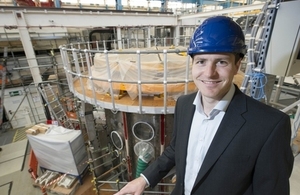Rising star to lead UK’s fusion energy programme
Professor Ian Chapman has been appointed Chief Executive of the UK Atomic Energy Authority by Universities and Science Minister Jo Johnson.

New CEO, Prof Ian Chapman
Professor Chapman will take over the role from present CEO Steve Cowley on 1 October. He will lead the UK’s magnetic confinement fusion research programme at Culham Science Centre as the new MAST Upgrade experiment approaches its 2017 launch – and the operation of the world’s largest fusion device, JET, on behalf of European scientists. He will also take forward UKAEA’s increasing range of hi-tech activities at the Culham site near Oxford, including the recently-opened Materials Research Facility, the RACE robotics centre, and the Oxford Advanced Skills apprentice training facility.
At 34, he is one of the youngest CEOs of a major research centre – something he very much sees as a positive:
Whilst I am young, I am also experienced. I hope my profile means that fusion, and its huge potential to give the world cleaner energy, will get noticed. Furthermore, I hope my appointment will inspire the next generation of scientists and engineers to make a success of ITER, the international fusion project which in my opinion is the most important experiment mankind has ever done.
Steve Cowley leaves a tremendous legacy – exciting plans for JET, the genuinely unique MAST Upgrade nearing completion and the vibrant new Materials Research Facility, RACE and Oxford Advanced Skills programmes here at Culham. I am determined to push on with the great work he started.
Ian Chapman has had a meteoric rise within UK fusion research. Having received his MSc in Mathematics and Physics from Durham University, Ian joined Culham in 2004 as a graduate whilst completing a PhD with Imperial College London. He took various programmatic roles before rising to become Head of Tokamak Science in 2014 and Fusion Programme Manager in 2015. He holds a visiting professorship at Durham University.
Universities and Science Minister Jo Johnson said:
I am extremely pleased to appoint Professor Ian Chapman as CEO of the UK Atomic Energy Authority. He is a real asset to the sector and will use his energy and expertise to promote the UK’s fusion research both at home and internationally.
Steve Cowley is delighted with the appointment:
Ian has risen quickly for good reason: he is a world-class scientist, a thoughtful manager, and a strategic thinker of the first order – astonishing in one so young. Culham is a precious UK asset and I am pleased that it will be in such good hands.
Ends
Photograph of Professor Ian Chapman at Culham Science Centre is attached. For more information or interviews please contact Nick Holloway, UKAEA Media Manager, at nick.holloway@ukaea.uk or on 01235 466232.
Notes to Editors
United Kingdom Atomic Energy Authority
The UK Atomic Energy Authority (UKAEA) carries out fusion energy research on behalf of the Government at Culham Science Centre near Abingdon in Oxfordshire. It is also developing Culham as a location of hi-tech research and business, with around 40 tenant companies now on site and UKAEA’s new RACE robotics centre and Materials Research Facility opening earlier in 2016.
UKAEA’s fusion lab Culham Centre for Fusion Energy oversees Britain’s fusion programme, headed by the MAST Upgrade (Mega Amp Spherical Tokamak) experiment. It also hosts the world’s largest fusion research facility, JET (Joint European Torus), which it operates for European scientists under a contract with the European Commission.
Further information is available at www.gov.uk/ukaea.
Fusion energy research
Fusion research aims to copy the process which powers the Sun for a new large-scale source of clean energy here on Earth. When light atomic nuclei fuse together to form heavier ones, a large amount of energy is released. To do this, fuel is heated to extreme temperatures, ten times hotter than the centre of the Sun, forming a plasma in which fusion reactions take place. A commercial power station will use the energy produced by fusion reactions to generate electricity.
Fusion has huge potential as a long-term energy source that is environmentally responsible (with no carbon emissions) and inherently safe, with abundant and widespread fuel resources (the raw materials are found in seawater and the Earth’s crust).
Researchers at Culham are developing a type of fusion reactor known as a ‘tokamak’ – a magnetic chamber in which plasma is heated and controlled. The research is focused on preparing for the international tokamak experiment ITER, now being built in southern France. ITER – due to start up in 2025 – is designed to show that fusion can work at the scale of a powerplant, and if successful should lead to electricity from fusion being on the grid by 2050.
Fusion research at Culham is funded by the Engineering and Physical Sciences Research Council and by the European Union under the EURATOM treaty.
Updates to this page
-
Change from nuclear fusion to fusion energy wording
-
First published.